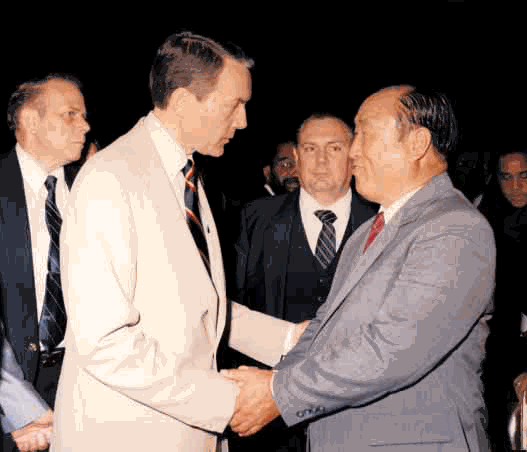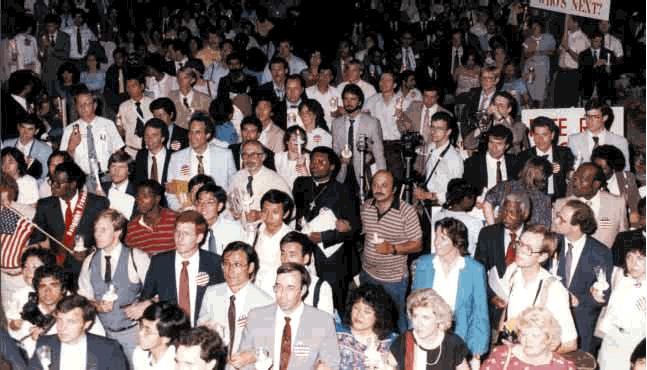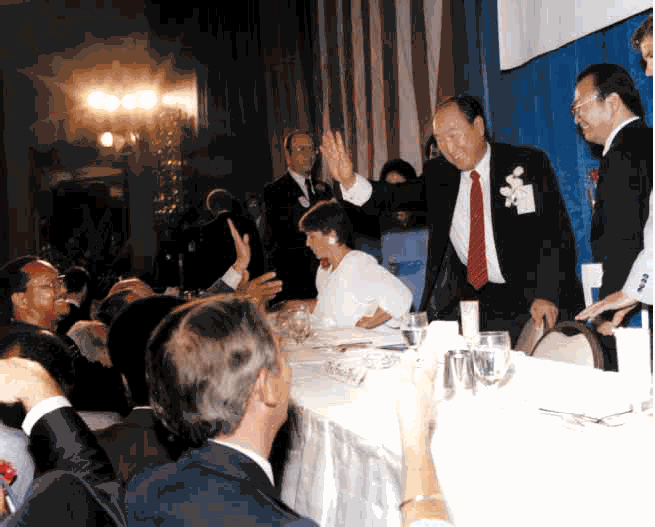
40 Years in America

|
|
40 Years in America |
|
Grassroots Support

After the Senate Judiciary Subcommittee on the Constitution hearing, from left: unknown, Sen. Orrin G. Hatch, Dr. Everett Siliven, and Rev. Moon.
It would have been an exaggeration to assert that a "Unification sunrise" was dawning upon the world in 1985. However, the climate had assuredly changed and the movement picked up a substantial amount of grassroots support. This was an accelerating process as an increasing and diverse number of Americans protested what they regarded as Reverend Moon’s victimization by the U.S. government. To be sure, some of them carefully distanced support for Rev. Moon’s religious or civil liberties from support of his theology or program.
Others, particularly from the minority and Black communities, viewed Rev. Moon as a fellow victim of racial prejudice and were less concerned about doctrinal distinctions. For them, Rev. Moon was a martyr and scapegoat. The movement deftly channeled this support into a variety of alliances, coalitions, committees and fellowships. However, the spontaneous support that emerged was more effective and consequential. By 1985, it was apparent even to the mainstream media that opposition to the government’s handling of Rev. Moon’s case was broad-based. In fact, many leading newspapers and columnists penned editorials on his behalf.
Prior to Rev. Moon’s tax case, a number of religious leaders, civil libertarians and academics came to the movement’s defense. Some of this was documented in previous sections, particularly in relation to the church’s legal gains. However, much of this support transcended legalities, and many of those who came to the movement’s defense became more-or-less permanent allies, at least in the battle for fair treatment. As early as 1977, Dean Kelley, Director for Civil and Religious Liberty of the National Council of Churches, characterized "deprogramming" in The Civil Liberties Review as "protracted spiritual gang-rape" and "the most serious violation of our religious liberty in this generation."
That same year in an article published in The Nation entitled, "Even a Moonie Has Civil Rights," sociologist Thomas Robbins suggested that once "persecution of deviant religion on obscurantist grounds of ‘mind control’" was established, "its application to political dissidents may be inevitable." Dozens of other libertarians and academics, some of whom the movement had cultivated, others with whom it had no relationship, concurred.
The church gained broad-based support for extending constitutional protections to its members in stages, only after abuses were apparent and a matter of public knowledge. The same pattern repeated itself in Rev. Moon’s tax case. Initially, there was very little publicity. The IRS investigation was conducted with little fanfare, as were the grand jury hearings. It was only with Rev. Moon’s indictment and arraignment on October 22, 1981 that the issue became public.
Even then, it would not have evoked comment had not the church sponsored a large public rally for followers and supporters on the steps of Foley Square Courthouse in Manhattan. Replete with a massive "We Shall Overcome" banner that exhorted those present to "Protect Religious Liberties and Minority Rights," the movement did not seek common cause with cultural elites, at least not at first, but rather with the downtrodden and disenfranchised. As Rev. Moon stated in his rally address, "I came back to America not just for my own vindication. I came back to America as a representative of all those who suffer governmental injustice, racial prejudice or religious bigotry.... Today I declare war against these enemies."
The movement subsequently announced that it had established an initial endowment of $2,000,000 for the creation of a Minorities Alliance International (MAI). It also published the text of Rev. Moon’s Foley Square address in The New York Times. While this provided grounds for the government’s veto of Rev. Moon’s request for a bench trial, it also publicized his situation.
The movement essentially pursued two tracks in its efforts to influence public opinion. First, it continued to build support from the ground up through activities funded by the MAI, especially among Black clergy. Second, it enlisted high-powered legal assistance. The movement achieved a major breakthrough when Laurence Tribe, "one of the law’s most brilliant scholars" and a "fearsome presence in the courtroom," agreed to work on Rev. Moon’s appeal. Tribe, a Harvard professor of constitutional law with "impeccable" liberal credentials, joined the defense team after Rev. Moon’s conviction but brought instant credibility and visibility to the case. More importantly, he raised a number of constitutional concerns that resonated with mainstream religious bodies.
Mainly, he pointed out that Rev. Moon was unfairly prosecuted and convicted for financial practices that were common among larger, established churches. The specter of unwarranted government intrusion into church affairs was something that observers had not previously noted or taken seriously about the case. As a consequence of this concern but also, doubtless, as a result of Tribe’s reputation and extensive contacts, major religious organizations began to join in support of the defense’s position. The National Council of Churches, the American Baptist Churches U.S.A., the United Presbyterian Church U.S.A., the African Methodist Episcopal Church, the Christian Legal Society, the Unitarian Universalist Association, and the National Black Catholic Clergy Caucus as well as the American Civil Liberties Union and New York Civil Liberties Union all submitted amicus curiae ("friend of the court") briefs before the U.S. Court of Appeals. A nationally syndicated columnist quoted Laurence Tribe as saying that Rev. Moon’s tax-evasion conviction was "the most significant threat to religious freedom in the United States in many decades." A religion writer for UPI quoted Tribe as saying,
For the first time in our history, a federal court has authorized the government to completely override a religious argument. Religion was systematically, brutally removed from this case... [The trial court’s decision] exposes every religious body, its spiritual leaders and all of its donors to the threat of criminal liability whenever a trial court or jury might later choose, in deciding the issue of ownership, to reject or ignore the doctrines and beliefs of the church and its adherents as to how funds raised for religious purposes should be held, spent and classified.
By the time Laurence Tribe filed a petition before the U.S. Supreme Court, support for Rev. Moon’s position had reached landslide proportions. The Southern Christian Leadership Conference (SCLC) announced on December 21, 1983 that they would support the appeal, and even The Washington Post editorialized that "the case deserves attention and full Supreme Court review." By April 1984, forty groups and individuals representing more than 120 million Americans had filed amicus curiae briefs in support of the appeal, including the National Association of Evangelicals, the National Conference of Black Mayors, the National Bar Association, The Church of Jesus Christ of Latter Day Saints, the Attorney Generals of Hawaii, Oregon and Rhode Island, Eugene McCarthy and Clare Booth Luce. In May, Donald Shriver, president of Union Theological Seminary in New York, Dr. Harvey Cox of Harvard Divinity School, Rev. Theodore Hesburgh, president of Notre Dame, and Dr. Balfour Brickner of Stephen Wise Synagogue in Manhattan were part of a large group of religious leaders who described Rev. Moon’s conviction as "deeply disturbing" in an open letter to President Reagan.
The Supreme Court’s refusal on May 14, 1984 to review Rev. Moon’s petition despite this groundswell of support set off a series of "Rallies for Religious Freedom." The first, which brought together 300 clergy and approximately 200 lay leaders from 60 denominations, took place in the ballroom of the Hyatt Regency in Washington, D.C. on May 30th. It was co-chaired by Rev. Joseph Lowery, chairman of the SCLC, and Dr. Tim La Haye, president of Family Life Seminars and of the Moral Majority in California. They also served as co-chairs of the Ad Hoc Committee for Religious Freedom. The two-and-one-half hour rally ended with La Haye stating that Rev. Moon’s confinement would be "a prelude to our future confinement." He then challenged all present to stand with him and "say as one individual, ‘I believe in religious freedom so much I am willing, if necessary and allowed, to spend one week of those eighteen months with Reverend Moon.’" One account of the meeting noted, "Almost everyone in the hall stood, clapping and cheering." A similar rally followed in New York, co-chaired by former Senator and presidential candidate Eugene McCarthy on June 11th. The Ad Hoc Committee for Religious Freedom sponsored more than twenty such rallies throughout the nation that month.

The candlelight pageant in Washington, D.C.
On June 26, 1984, the Senate Judiciary Committee’s Subcommittee on the Constitution, chaired by Sen. Orrin Hatch (R-Utah) conducted a hearing on religious liberty to which many of the principals in Rev. Moon’s tax case, as well as several other religious leaders embroiled in litigation, were invited to offer testimony. At least 350 persons, many of them Christian ministers invited by the Ad Hoc Committee on Religious Freedom, and numerous media crews crowded into the hearing room in the Dirksen Senate Office Building.
Sen. Hatch commented that there seemed to be a "recent acceleration" of such cases and that "Jailings of ministers are especially disturbing to me." In his prepared remarks, Rev. Moon stated, "In 1971, God called me to come to America and... for the last 12 years, I have given my heart and soul and every drop of sweat and tears for the sake of this nation." He listed a number of the vast array of projects undertaken by the movement at the cost of "several hundred million dollars," denied that he had defrauded the U.S. government of a few thousand dollars, and expressed gratitude that God was "using me as an instrument to lead the fight for religious freedom and to ignite the spiritual awakening of America."
Although there were several sharp questions from the ranking Democrat on the panel, the entire event was something of a love fest with ministers pressing forward to shake hands with Rev. Moon and express their thanks. Following Rev. Moon’s imprisonment on July 20, 1984, there were more demonstrative rallies. On July 25th, over six thousand people gathered in Washington, D.C. to participate in "A Pageant for Religious Freedom." It included an afternoon Seminar on Religious Freedom for ministers; an evening pageant at Constitution Hall with a musical-theatrical tribute to memorable moments in American history as related to religious liberty, and rousing speeches including one by In Jin Moon, Rev. Moon’s second-oldest daughter; and a candlelight march to Lafayette Park in front of the White House.
A series of rallies and marches ensued which featured "mock jails" constructed of shiny metal bars holding ministers from different denominations closely watched by "IRS" and "Department of Justice" guards. Some rallies included mock funeral services, replete with carriage hearses and caskets marked "First Amendment." Rallies, seminars and banquets of various kinds continued throughout the length of Rev. Moon’s imprisonment. The movement attempted to build on this ferment and "educate" ministers in several ways. Beginning in July, it sponsored Common Suffering Fellowship seminars for clergy. Essentially, it translated the "jail pledge" that many ministers had made into attendance of the four-day seminar in Washington, D.C. that included lectures not only on religious liberty and Christian activism (followed by visits to their representatives and senators) but also on themes drawn from Unification theology. The movement also involved several thousand clergy contacts with its CAUSA Ministerial Alliance.
In August 1985, Rev. Moon conceived the idea of sending video tapes on Unification theology, a brochure and booklet about the movement, an Outline of the Principle text, a book of his talks entitled God’s Warning to the World, and a personal "Letter from Danbury" to 300,000 ministers and religious leaders in the United States. It required several months to produce, duplicate, label and package the videotapes, which was done entirely in-house, and 28 tractor trailers to ship all 300,000 packages, a million pounds in total weight, to the mailing location.
Efforts to introduce Unification theology provided ammunition for critics who characterized the various committees and coalitions for religious freedom as "Moonie fronts." A Washington Post article that discussed the relationship of the Unification Church to the Ad Hoc Committee for Religious Freedom, quoted one minister as saying he "felt a bit used" by his coming to the Washington Pageant for Religious Liberty and finding such a heavy emphasis on Rev. Moon. Likewise, Unification Church President Mose Durst found it necessary to explain that the purpose of the 300,000-tape video project was "to communicate what Reverend Moon’s teachings are, not to convert anyone." Time magazine referred to "Sun Myung Moon’s Goodwill Blitz" in describing the $4.5 million video project as "only the latest tactic in a $30 million cosmetic campaign being waged by the Moon movement...[to] polish the sect’s tarnished image and achieve mainstream respectability." Shaw University, similarly, found itself accused of being bought-off in awarding Rev. Moon an honorary doctorate degree in May 1985.
To a large extent, these charges simply reflected the tenuous quality of all coalitions. The reality was that although the movement funded and orchestrated most of the religious freedom rallies, it dealt with a legitimate issue about which there was widespread discontent. As Rev. Donald Sills, executive director of the Coalition of Religious Freedom, pointed out several times, "In 1976, there were 45 cases of government litigation against churches, pastors, and religious organizations. By 1980, that figure had increased to 2,100. Today, in 1985, there are approximately 8,000 cases." In this respect, Rev. Moon’s plight represented a larger problem. Because of this, despite strains and disparate motivations, the coalition for religious freedom held together and even expanded.
There was no more reliable indicator of this than the "God and Freedom Banquet" which welcomed Rev. Moon back from prison on August 20, 1985. Earlier that day, twenty prominent clergy including Rev. Jerry Fallwell, head of the Moral Majority, and Rev. Joseph Lowery, president of the SCLC, usually at opposite ends of the religious-political spectrum, held a news conference at which they decried government encroachment upon religion and called upon President Reagan to pardon Rev. Moon. That evening, more than 1,600 clergy and prominent lay people gathered at the Omni Shoreham Hotel in Washington, D.C. Forty clergy were seated at the head table under a huge welcome banner. While many of the familiar religious liberty themes were touched upon, the evening was really a welcome and a tribute to Rev. Moon. Cards, a huge trophy, and a Native American ceremonial drum were exchanged and a succession of speakers paid tribute to Rev. Moon’s sacrifice and devotion "during the time of his unjust imprisonment." One Unification member attempted to set the banquet in historical context,
It was as if, in the forgiving eyes of God, the clock had been turned back to...[Rev. Moon’s] first arrival in the United States, when he was welcomed with acclamations, and all the intervening years of ugliness had been dispelled like a ghastly nightmare.... But a marked difference remained between the pristine interval when...[Rev. Moon] was first greeted in America, and the present time. In the early 1970’s, the people who welcomed him were innocent of what he taught and what he stood for. What they had presented to him they gave, childlike, out of a vague feeling of goodwill. But the people who applauded...[Rev. Moon] tonight were familiar with his ideals and his work, and some had even imperiled their reputations to stand in support of him.
Rev. Moon made use of the occasion to teach. After extending his appreciation to those who had supported him through the court battles, amicus briefs, and rallies, he stated that the determination that underlay his whole ministry and life was "to relieve the great and long suffering of God." Since "the world is ignorant of God’s heart of suffering," he commented that it was his lot and that of his movement to be "misunderstood and persecuted." However, given what he termed "the urgency of my mission before God," he stated that the lack of understanding and persecution "has not really mattered very much to me."

Rev. Moon at the God and Freedom Banquet, Washington, D.C., August 20, 1985.
In the knowledge that he was addressing "clergy who also have been participants in the fulfillment of God’s will," he understood that their welcome was "not a personal welcome for the individual, Reverend Moon, but is a testament to that will of God for which I have lived my life." He, thereafter, challenged all present to repent, to "transcend denominationalism," and "to consider seriously the mission of Christianity to lead a supra-denominational, cultural revolution on a worldwide scale." The challenge was much the same as that which he had issued at the Washington Monument nearly a decade earlier. The difference was that his listeners and the movement were more ready to respond.
Download entire page and pages related to it in ZIP format
Table of Contents
Information
Tparents Home